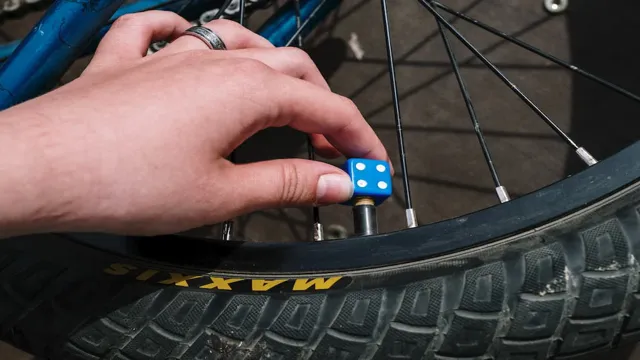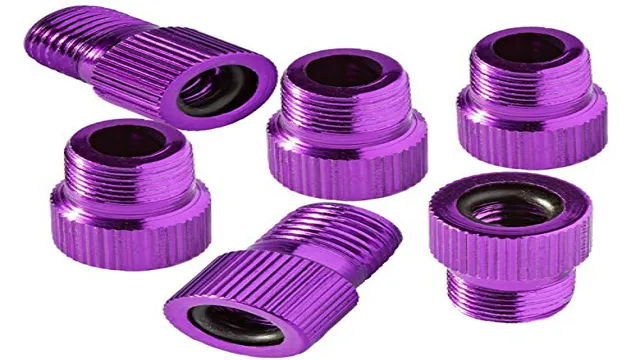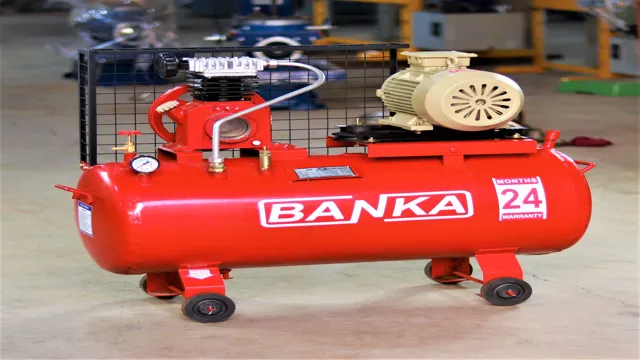How to Inflate a Bike Tire with an Air Compressor in 5 Easy Steps: A Comprehensive Guide

Whether you’re an avid cyclist or occasional rider, one thing you’ll eventually need to do is inflate your bike tire. While some people prefer using a traditional hand pump, others find that inflating their bike tire with an air compressor provides a quicker and more efficient solution. However, using an air compressor can seem daunting if you’ve never done it before.
Don’t worry, though, as with the right tools and steps, inflating your bike tire with an air compressor is easy and straightforward. In this article, we’ll go over everything you need to know to properly inflate your bike tire with an air compressor, so you’ll be back on the road in no time.
What You Will Need
If you’re wondering how to inflate a bike tire with an air compressor, then you’re in luck because it’s a relatively simple process that can save you time and effort. First, you’ll need an air compressor and a gauge to measure the pressure. You’ll also need a hose and a nozzle attachment to connect the compressor to the tire valve.
Make sure to confirm the correct tire pressure and don’t exceed it. Excess pressure can cause the tire to burst, so be attentive to manufacturer recommendations. It’s usual for the tire pressure to change due to weather and riding conditions, so regularly checking and adjusting the tire pressure can help maintain and prolong the life of your tires and bike.
So, the next time your bike tires need air, give inflating them with an air compressor a try using the recommended pressure.
Air compressor
Air compressor If you’re thinking about buying an air compressor, there are a few essential things that you’ll need. The first thing is a clear understanding of what you’ll be using the compressor for. This will help you to determine the size and power of the compressor you need.
You’ll also need to consider the type of tools you’ll be using with the compressor, as different types of tools require different levels of pressure and air flow. In addition to the compressor itself, you’ll need an air hose, a set of fittings and adapters, and possibly an air tool kit. You may also want to consider purchasing a moisture separator to ensure that the air coming out of the compressor is dry and clean, which is essential for protecting your tools and preventing rust build-up in the compressor tank.
By considering these factors, you’ll be well on your way to selecting the right air compressor and accessories for your needs.

Air chuck
When it comes to inflating tires, an air chuck is an indispensable tool to have. To use an air chuck, you will need an air compressor, a tire gauge, and a valve stem tool. First, locate the valve stem on your tire and unscrew the valve cap.
Then, attach the air chuck to the valve stem firmly and securely. Turn on the air compressor and let it run until the tire reaches the desired pressure. Use the tire gauge to check the pressure and release or add air as necessary.
Once you’ve achieved the correct pressure, remove the air chuck and replace the valve cap. It’s important to use an air chuck and tire gauge to avoid overinflating or underinflating the tire, which can cause safety hazards and damage to the tire. Always double-check the recommended tire pressure for your vehicle and adjust accordingly.
With these tools and preparation, inflating your tires will be a breeze.
Tire pressure gauge
One essential item for every car owner to have in their arsenal is a tire pressure gauge. It’s important to regularly check your car’s tire pressure, as under-inflated or over-inflated tires can lead to poor fuel economy, premature tire wear, and decreased handling and safety on the road. To check your tire pressure accurately, you’ll need a tire pressure gauge.
Thankfully, this tool is readily available at most automotive stores and is relatively inexpensive. You can choose from various types, including digital or analog gauges, and even some that have inflators built-in. It’s important to ensure that you select the correct gauge for your vehicle’s tire size.
With this handy tool, you can quickly and easily check your tire pressure, making sure that your car’s performance and safety are always at their optimum level.
Steps
Inflating a bike tire with an air compressor can seem daunting, but with a few simple steps, it can be done quickly and easily. First, make sure you have the appropriate valve adapter for your bike tires. This can be purchased at your local bike shop or online.
Next, check the recommended PSI for your tires, as over-inflation can result in a blowout. Once you have the correct adapter and PSI, attach the adapter to the valve stem and turn on the compressor. Slowly add air to the tire, checking the pressure periodically with a pressure gauge.
Once the desired PSI is reached, turn off the compressor and remove the adapter. Remember to check your tire pressure regularly to ensure a safe and smooth ride. With these steps, inflating your bike tire with an air compressor is easy as pie.
Step 1: Prepare the air chuck and the compressor
When it comes to inflating your bike tires, having the right tools is key. Getting started, prepare the air chuck and the compressor. First, make sure the air chuck is securely attached to the air hose.
Then, check the pressure of the compressor to ensure it’s at the correct level for your tires. Don’t forget to refer to the manufacturer’s recommendations for pressure levels. Once you have everything in place and ready to go, you’re all set to start inflating your tires and getting back on the road.
Remember, proper tire inflation is essential for both your safety and the longevity of your bike tires.
Step 2: Remove the valve cap and attach the air chuck
Once you’ve determined the correct tire pressure for your vehicle, it’s time to start inflating your tires. The first step is to remove the valve cap from the tire you’ll be inflating. Don’t lose the valve cap as it can help keep out dirt and moisture, which can damage the valve.
After removing the valve cap, you’ll need to attach the air chuck to the valve stem. An air chuck is a device that attaches to the valve stem and allows you to inflate your tires. There are different types of air chucks available, so make sure you select the one that’s compatible with your tire valve.
Once you’ve attached the air chuck, check if it’s holding securely by giving it a gentle tug. If it’s not, reattach it until it’s securely in place. By following these simple steps, you’re well on your way to inflating your tires to the correct pressure.
Step 3: Inflate the tire to the recommended pressure
When it comes to inflating your tire, it’s essential to follow the recommended pressure level. This step is crucial as it affects the tire’s performance, safety, and longevity. Underinflated tires can damage the tire walls, lead to poor handling, reduce fuel efficiency, and even cause a blowout.
Overinflated tires, on the other hand, reduce the tire’s contact area, making your ride bumpy and leading to a shorter tire lifespan. The recommended pressure for your tire can be found in the car’s manual or the tire’s sidewall. You can inflate the tire using a manual or electric pump, and always check the pressure with a tire gauge.
Remember to check the pressure when the tire is cold and not after a long drive. Inflate your tire to the recommended pressure in small increments, checking the pressure after each one until it reaches the correct level. Following this step will ensure that you have a smooth, safe, and comfortable ride.
Step 4: Check the pressure and adjust if necessary
After inflating your tires, it’s important to check the pressure and adjust it if necessary. The recommended PSI (pounds per square inch) for your tires can be found in your car’s manual or on the tire itself. Use a tire pressure gauge to check the pressure and compare it to the recommended PSI.
If it’s too low, use an air compressor or air pump to add air until it reaches the correct level. If it’s too high, you can release some air by pressing on the valve stem with the tire pressure gauge until it reaches the recommended level. Keeping your tires at the recommended PSI not only ensures that your car is running efficiently, but it can also improve your safety on the road by improving handling and reducing the risk of blowouts.
So make sure to check your tire pressure regularly to keep your car in top shape!
Tips
If you want to inflate your bike tire quickly and efficiently, an air compressor can be a great tool. However, there are some important steps you need to follow to avoid damaging your tire or your bike. First, make sure you have the right nozzle for your valve – there are different types of valves, and using the wrong nozzle can cause air to leak or damage your valve stem.
Next, check the recommended PSI (pounds per square inch) for your tire – you can find this information on the sidewall of your tire or in the manufacturer’s instructions. Overinflating your tire can cause it to burst, while underinflation can make it difficult to ride. Once you’ve connected the nozzle to your valve, turn on your air compressor and gradually increase the pressure until you reach the recommended PSI.
Stop and check the pressure frequently to avoid overinflation. Finally, disconnect the nozzle and replace the valve cap. With these tips in mind, you can safely and easily inflate your bike tire with an air compressor and get back on the road in no time.
Avoid over-inflating the tire
When it comes to maintaining your vehicle’s tires, one of the most important things to remember is to avoid over-inflating them. Over-inflating your tires can lead to a number of negative consequences, including reduced traction, uneven wear, and even blowouts. So, what can you do to avoid over-inflating your tires? The first step is to check your vehicle manufacturer’s recommended tire pressure, which you can usually find in your owner’s manual or on a sticker inside the driver’s side door frame.
Be sure to also check the pressure regularly using a tire gauge, especially during temperature changes, as tire pressure can fluctuate. By following these simple tips, you can help ensure your tires stay in optimal condition and safer for you to drive.
Stay within the recommended pressure range
When it comes to maintaining your vehicle’s tires, staying within the recommended pressure range is crucial. First, check your car’s owner’s manual or the tire manufacturer’s specifications to ensure you know what range your tires require. Proper tire pressure will not only improve fuel efficiency and handling, but it will also help your tires last longer and reduce the risk of a blowout.
Overinflated tires can cause a rough ride and premature wear in the center of the tire, while underinflated tires may cause a bumpy ride and uneven wear on the edges. To make it easier to monitor your tire pressure, consider investing in a good-quality tire pressure gauge and checking it regularly. It’s a small step that can make a big difference in the longevity and performance of your tires.
So, take care of your tires by staying within the recommended pressure range and enjoy a smoother and safer ride.
Conclusion
In conclusion, inflating your bike tire with an air compressor is like a superhero power that you never realized you had. With the right tools and a bit of know-how, you can save yourself the time and hassle of manually pumping up your tire. So, don your cape, strap on your helmet, and let the air compressor be your trusty sidekick as you ride off into the sunset on your perfectly inflated bike.
“
FAQs
What equipment do I need to inflate a bike tire with an air compressor?
You will need an air compressor, an air chuck or inflator, and a pressure gauge.
Can I use any air compressor to inflate a bike tire?
Yes, as long as it can deliver the required amount of pressure for your bike tire.
How do I attach the air chuck to the valve stem of my bike tire?
Push the chuck onto the valve stem and lock it in place by pressing the lever or twisting the collar.
What pressure should I inflate my bike tires to?
Check the recommended pressure range stated on the side of the tire or consult the manufacturer’s guidelines.
How do I check the current pressure of my bike tires before inflating them?
Use a pressure gauge to measure the pressure of the tire, and inflate or deflate as needed to achieve the recommended pressure.
Can I overinflate my bike tire with an air compressor?
Yes, it can lead to a blowout or damage the tire. Always follow the recommended pressure range.
What should I do if I cannot get the air chuck to seal properly with the valve stem?
Check the valve stem for damage or dirt buildup, and make sure the chuck is fully inserted and locked in place. You can also try using a different type of chuck or inflator.



